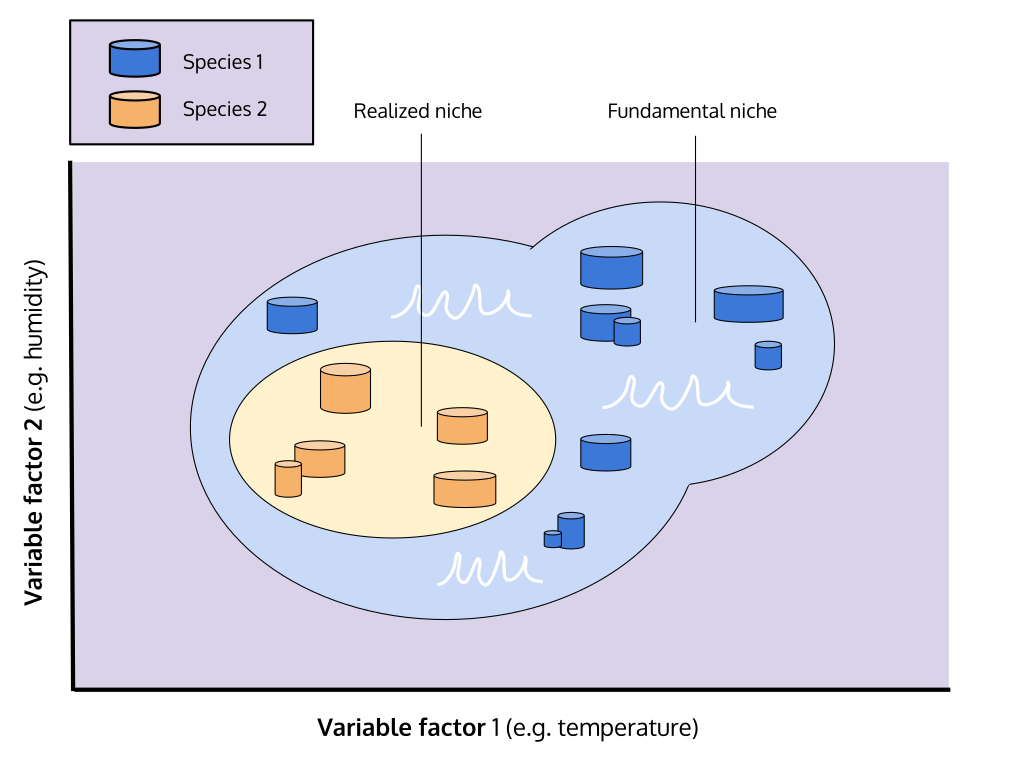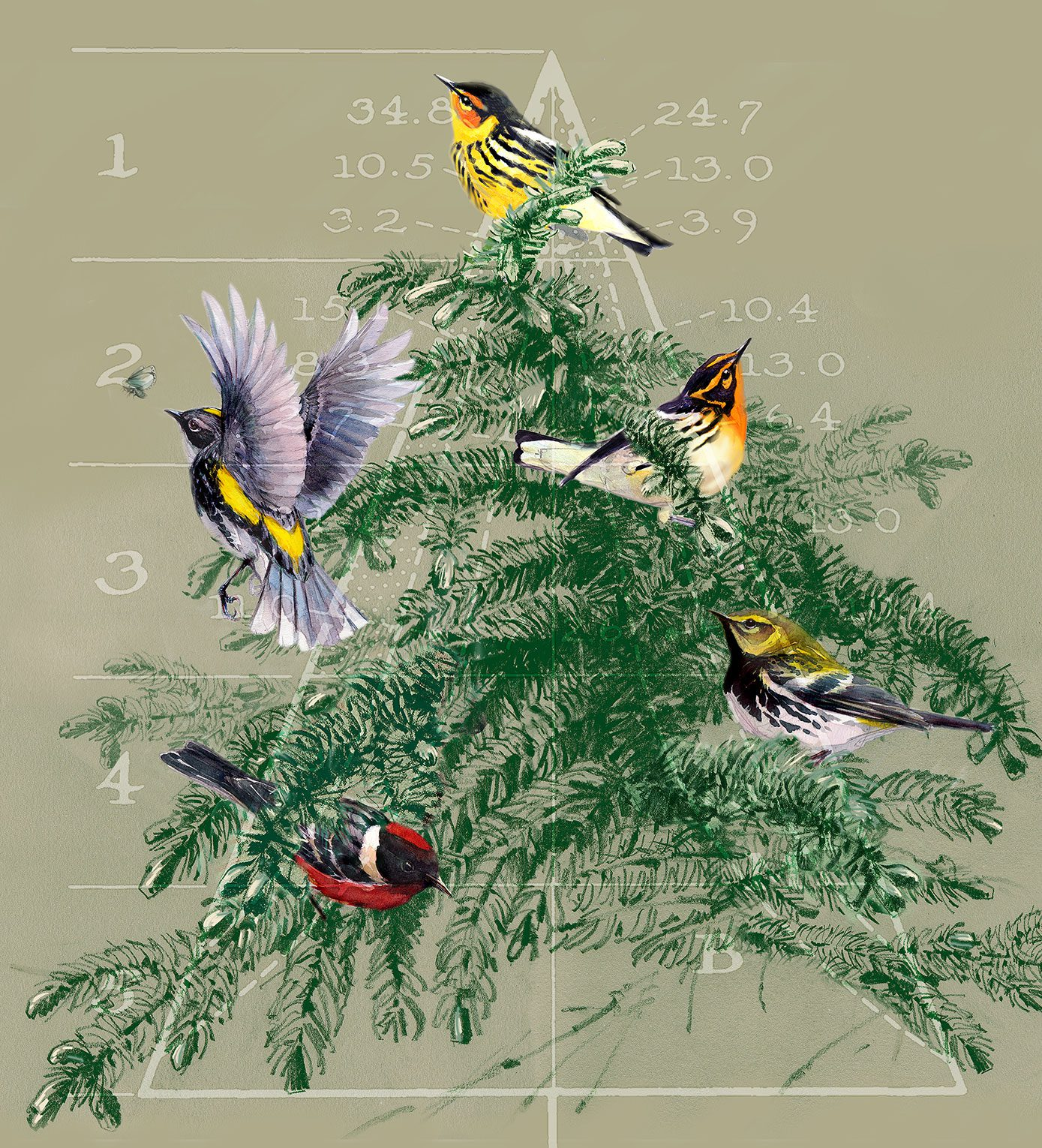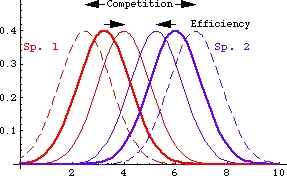The intricate dance between organisms and their environment is encapsulated in the concepts of niche and habitat. These terms, while distinct, are interrelated and crucial for understanding the complex interactions that shape the biodiversity and structure of ecosystems.
Fundamental vs. Realised Niche
Fundamental Niche
A fundamental niche is the theoretical realm encompassing the full spectrum of environmental conditions under which an organism can exist, grow, and reproduce. It is a concept rooted in a world without biotic interactions, a space where an organism’s existence is solely dictated by abiotic factors.
Physical Parameters
Temperature: Every species has a range of temperatures within which it can survive. The fundamental niche outlines these optimal and extreme conditions.
Humidity and pH Level: These are additional abiotic factors that delineate the boundaries of existence for a species.
Biological Parameters
Food Availability: In the absence of competitors, a species might be able to feed on a variety of food sources.
Absence of Predators: Without predation, the geographical and ecological spread of species could be broader.
Realised Niche
In contrast, a realised niche is narrowed by the actual conditions under which a species exists, a reduction attributed to biotic and abiotic constraints. It’s a reflection of the organism’s adaptations and the ecological pressures it faces.

This schematic shows a species’ fundamental niche (the full abiotic tolerance space) and the smaller realised niche shaped by biotic constraints such as competition and predation. The layout mirrors textbook usage, keeping labels minimal and clear. Source.
Biotic Constraints
Competition: The presence of other species competing for the same resources can limit the spread and abundance of a species.
Predation: Predators exert pressure that can limit the distribution of species to safer habitats or niches.
Abiotic Constraints
Climate Conditions: Extreme weather conditions, seasonal variations, and climate change can impact a species’ distribution.
Human Activities: Pollution, habitat destruction, and other anthropogenic factors can also restrict a species’ existence.
Niche Differentiation
Niche differentiation or resource partitioning is an ecological phenomenon that enables similar species to coexist within the same ecosystem. It’s a testament to the adaptability of life, showcasing the diversity and complexity of biological interactions.
Mechanisms of Niche Differentiation
Temporal Differentiation
Activity Patterns: Some species become nocturnal, while others are diurnal or crepuscular, reducing direct competition.
Breeding Seasons: Different species might breed during different seasons, reducing competition for nesting sites and food.
Spatial Differentiation
Habitat Segregation: Within a shared ecosystem, species might inhabit different areas to minimise competition.
Microhabitat Specialisation: Even within the same general area, species can specialise in specific microhabitats.
Diet Differentiation
Food Preferences: By evolving different feeding habits or preferences, species reduce direct competition for food.
Foraging Strategies: Different methods of finding and processing food can also lead to niche differentiation.
Example of Niche Differentiation
In a forest, two similar bird species might avoid competition by feeding on different types of seeds or by foraging at different heights in the trees. This separation in feeding habits and locations reduces direct competition, allowing both species to coexist.

Illustration of five warbler species partitioning a spruce tree by foraging height and position, a canonical case of spatial niche differentiation. Species names are included as helpful context beyond the syllabus’ generic example. Source.
Niche Overlap
Niche overlap is a scenario where two or more species share certain aspects of their niche. This overlap can lead to competition, and according to the competitive exclusion principle, no two species can occupy the exact same niche indefinitely.

Two Gaussian resource-utilisation curves for different species illustrate the degree of niche overlap and how realised use can contract or shift under competition. The figure also depicts possible evolutionary adjustments (not required by the syllabus but clarifying) with arrows showing reduced or increased overlap. Source.
Factors Influencing Niche Overlap
Resource Availability
Scarcity: When resources are limited, competition intensifies, leading to either competitive exclusion or niche differentiation.
Abundance: With abundant resources, niche overlap might not lead to intense competition, allowing temporary coexistence.
Environmental Conditions
Stability: Stable conditions might allow for more niche overlap as resources are predictably available.
Fluctuations: Environmental fluctuations can increase or decrease niche overlap and competition intensity.
Managing Niche Overlap
Adaptive Evolution
Behavioural Changes: Species might evolve different behaviours to reduce direct competition.
Morphological Adaptations: Physical adaptations can lead to the utilisation of different resources.
Coexistence Mechanisms
Reciprocal Alleviation: Sometimes, the mutual benefits of coexistence outweigh the costs of competition, leading to stable coexistence.
Example of Niche Overlap
Two rodent species might both feed on nuts and seeds in a forest. The significant niche overlap could lead to intense competition. However, one species might adapt to forage during the day while the other becomes nocturnal. This temporal niche differentiation reduces direct competition, allowing both species to coexist.
In the intricate tapestry of ecosystems, the concepts of fundamental and realised niche, niche differentiation, and niche overlap are threads that weave complex patterns of biodiversity. Each species, with its unique set of adaptations and interactions, occupies a niche carved out through millions of years of evolution, shaped by both the gentle hands of cooperation and the stern forces of competition. Understanding these concepts is not just an academic exercise but a journey into the heart of life’s diversity, offering insights into the resilience and vulnerability of the natural world.
FAQ
Predation is a crucial biotic factor that influences a species’ realised niche. Predators can limit the distribution and abundance of prey species, forcing them into specific habitats or behaviours that reduce predation risk. For example, a small mammal species might be capable of living in a variety of habitats (its fundamental niche), but due to the presence of predators, it might be restricted to areas with ample cover, like thickets or burrows (its realised niche). Thus, predation can significantly narrow the range of conditions and spaces where a species can exist.
Climate change can significantly impact niche differentiation and overlap by altering the environmental conditions of ecosystems. As temperatures rise, precipitation patterns change, and extreme weather events become more common, the abiotic factors that define species’ niches also shift. This can lead to changes in the distribution and behaviour of species, affecting both fundamental and realised niches. For instance, as temperatures rise, some species might move to higher altitudes or latitudes, leading to new interactions and competitions with other species, thus influencing niche overlap and differentiation.
Two species cannot have an identical realised niche in the same ecosystem for an extended period due to the competitive exclusion principle. This principle states that two species competing for the exact same resources cannot coexist indefinitely. One species will eventually outcompete the other, leading to the latter’s extinction in that particular environment or an evolution leading to niche differentiation. This differentiation can occur in various ways, such as temporal, spatial, or dietary changes, allowing both species to coexist by reducing direct competition for the same resources.
Niche overlap and carrying capacity are related in the context of resource availability and competition. When two species have a significant niche overlap, they compete for the same resources. This competition can affect each species’ population growth and sustainability, often leading to a reduction in the carrying capacity for both species. Carrying capacity refers to the maximum population size of a species that the environment can sustain indefinitely. In cases of niche overlap, the available resources must be shared among more individuals of competing species, potentially lowering the carrying capacity for each.
Human activities can significantly impact the realised niche of a species by altering both biotic and abiotic factors in an ecosystem. For instance, deforestation can lead to habitat loss, forcing a species to adapt to a smaller, fragmented habitat, thus narrowing its realised niche. Pollution can alter the quality of air, soil, and water, imposing additional abiotic constraints on where a species can survive. Overfishing or hunting can mimic the effects of increased predation, while the introduction of invasive species can heighten competition, each influencing the boundaries of a species’ realised niche.
Practice Questions
A fundamental niche encompasses the entire set of environmental conditions under which a species can survive, grow, and reproduce. It is theoretical and doesn’t consider biotic interactions like competition or predation. For example, a type of freshwater fish might theoretically be able to survive in a wide range of temperatures and depths. In contrast, a realised niche is the actual space that a species occupies in the ecosystem, considering both biotic and abiotic factors. Using the same example, the fish might only be found in specific areas of the river due to competition and predation.
Niche differentiation, or resource partitioning, allows multiple species to coexist in the same ecosystem by reducing direct competition. Each species adapts to utilise different resources or occupies different spaces or times, enhancing biodiversity. For instance, in a forest, one bird species might feed on insects in the canopy while another feeds on seeds on the forest floor. This separation in diet and space reduces competition and allows both species to thrive, contributing to the overall biodiversity of the forest ecosystem. Each species occupies a unique niche, leading to a more complex and diverse ecosystem.

